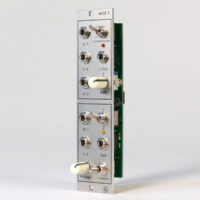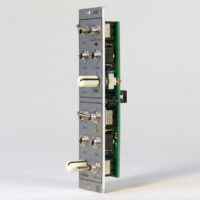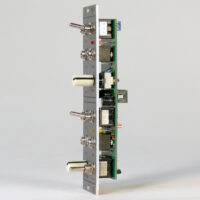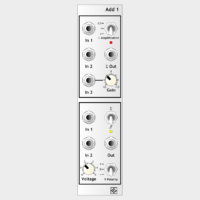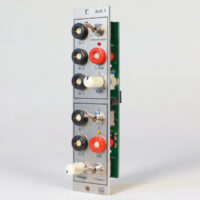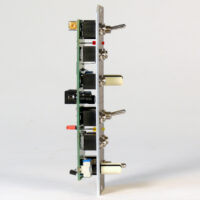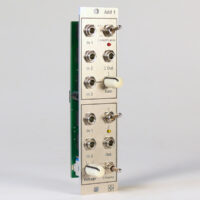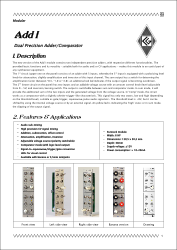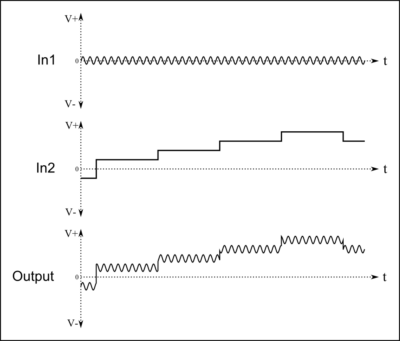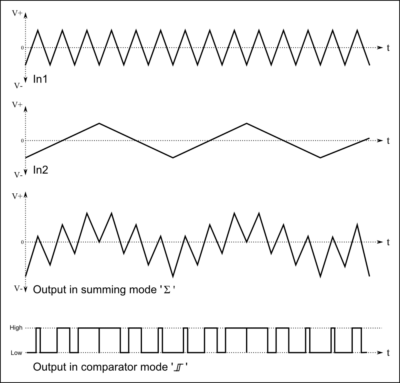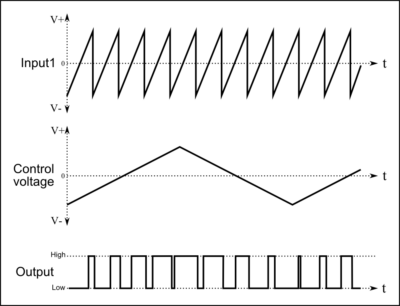Eurorack Module
Add1
Dual Adder/Comparator and Voltage Source
-
Audio sub-mixing
-
High precision CV signal mixing
-
Addition, substraction, offset control
-
Attenuation, amplification, inversion
-
Adjustable voltage source (polarity switchable)
-
Comparator mode (with logic level output)
-
Signal-to-squarewave/trigger/gate conversion
-
LEDs for visual control
-
Width: 6 HP
-
Dimensions: 128,5 mm x 30,2 mm
-
Depth: 30mm
-
Supply voltage: ±12V
-
Current: +12V: ≤30mA; -12V: ≈18mA
-
Optionally in banana version
The Add1 module contains two independent precision adders, with respective different functionalities. Their provided basic functions and its versality – suitable both for audio and/or CV applications – makes this module to an useful part of any synthesizer equipment.
» read more
The 1st circuit (▲ upper section of the module panel) consists of an adder with 3 inputs, whereby the 3rd input is equipped with a polarizing level knob for attenuation, slightly amplification and/or inversion of this input channel. The sum output has a switch for determing the amplification factor (either *0,5, *1,0 or *2,0); an additional red LED indicates if the output signal is becoming overdriven.
The 2nd circuit (▼ lower section of the module panel) is having two inputs and a summable voltage source with an amount control knob (level adjustable from 0 – 5V) plus inversion/zeroing switch. This output is switchable between sum and comparator mode. In sum mode, it will provide the sum of the two inputs and the generated voltage from the voltage source.
In ‘Comp’ mode, the circuit is working as a comparator with a slightly schmitt-trigger-like characteristic. This mode has only two states on the output, low and high (depending on the threshold level), suitable as gate/trigger, squarewave/pulse audio signal etc.. The threshold level is ≈0V, but it can be shifted by using the internal voltage source or by an external signal. An yellow led is indicating the ‘high’ state; in sum mode its showing the clipping of the output signal. » read less
» read more
The 1st circuit (▲ upper section of the module panel) consists of an adder with 3 inputs, whereby the 3rd input is equipped with a polarizing level knob for attenuation, slightly amplification and/or inversion of this input channel. The sum output has a switch for determing the amplification factor (either *0,5, *1,0 or *2,0); an additional red LED indicates if the output signal is becoming overdriven.
The 2nd circuit (▼ lower section of the module panel) is having two inputs and a summable voltage source with an amount control knob (level adjustable from 0 – 5V) plus inversion/zeroing switch. This output is switchable between sum and comparator mode. In sum mode, it will provide the sum of the two inputs and the generated voltage from the voltage source.
In ‘Comp’ mode, the circuit is working as a comparator with a slightly schmitt-trigger-like characteristic. This mode has only two states on the output, low and high (depending on the threshold level), suitable as gate/trigger, squarewave/pulse audio signal etc.. The threshold level is ≈0V, but it can be shifted by using the internal voltage source or by an external signal. An yellow led is indicating the ‘high’ state; in sum mode its showing the clipping of the output signal.
The 2nd circuit (▼ lower section of the module panel) is having two inputs and a summable voltage source with an amount control knob (level adjustable from 0 – 5V) plus inversion/zeroing switch. This output is switchable between sum and comparator mode. In sum mode, it will provide the sum of the two inputs and the generated voltage from the voltage source.
In ‘Comp’ mode, the circuit is working as a comparator with a slightly schmitt-trigger-like characteristic. This mode has only two states on the output, low and high (depending on the threshold level), suitable as gate/trigger, squarewave/pulse audio signal etc.. The threshold level is ≈0V, but it can be shifted by using the internal voltage source or by an external signal. An yellow led is indicating the ‘high’ state; in sum mode its showing the clipping of the output signal.
» read less
Examples
Addition ▲▼(both adders)
Addition of two signals; Sum signal is provided on the output:
Voltages In1 + In2 = Output voltage
▲ 1st adder: Inputs 1+2 ; Switch ‘∑-Amplification Factor’ = 1,00
or
▼ 2nd adder: Inputs 1+2 ; Switch in upper position ‘∑’
▼ Comparison between adding and comparator mode
Output waveforms of 2nd circuit (▼) with two triangle signals applied on Inputs In1+In2:
- Switch in upper position (addition)
(Yellow LED ∙ is indicating voltage on limit) - Switch in lower position (comparator
(Yellow LED ∙ is indicating comparator state ‘high’)


